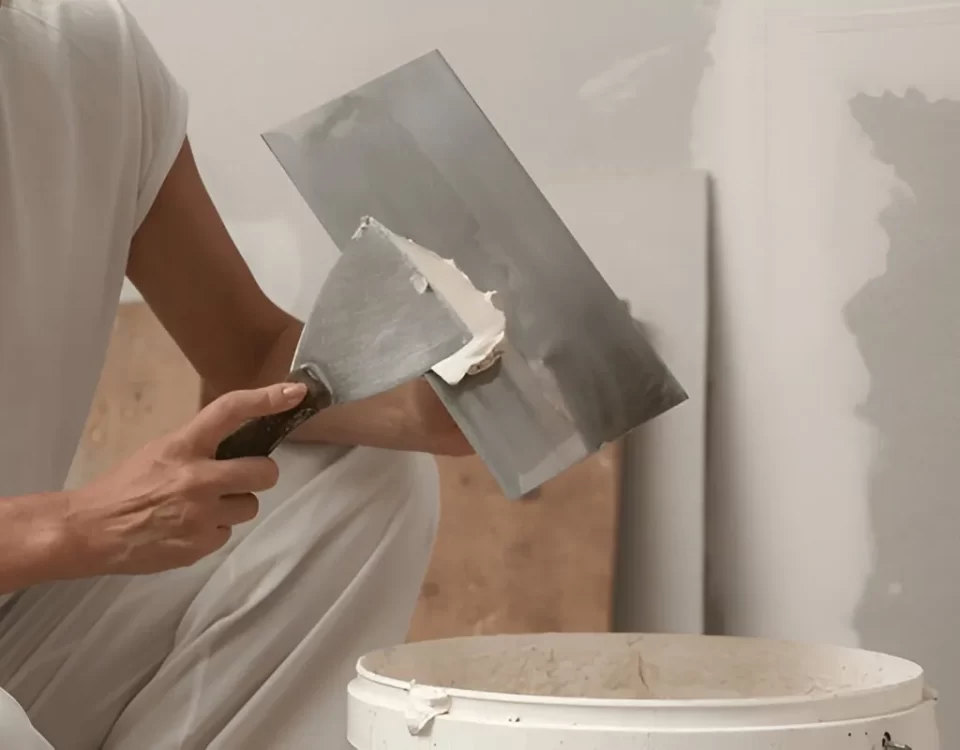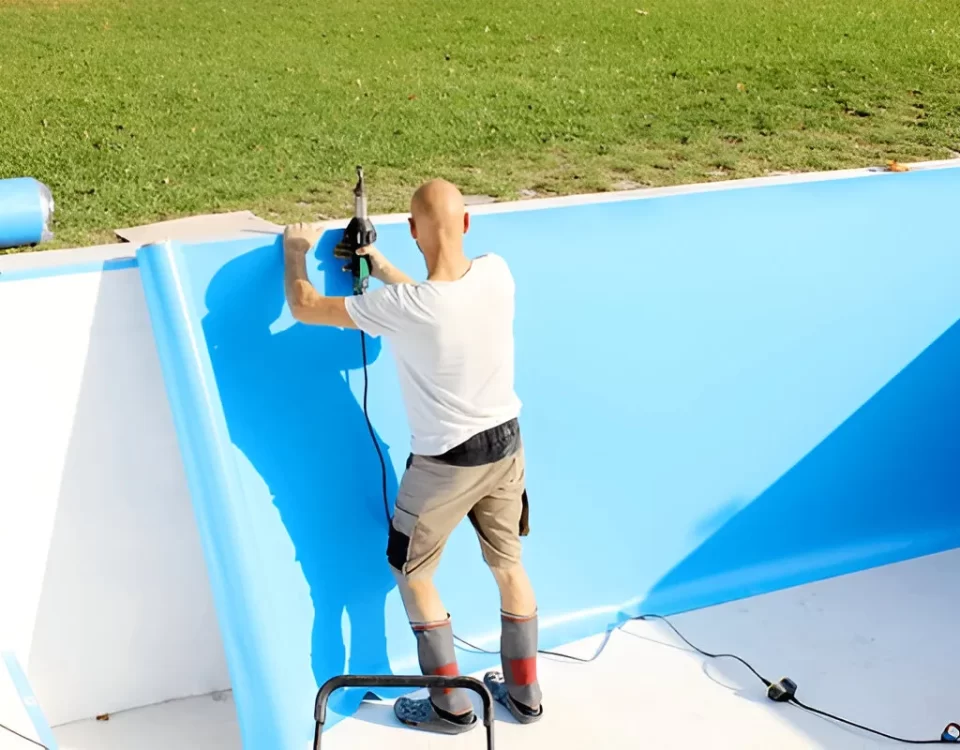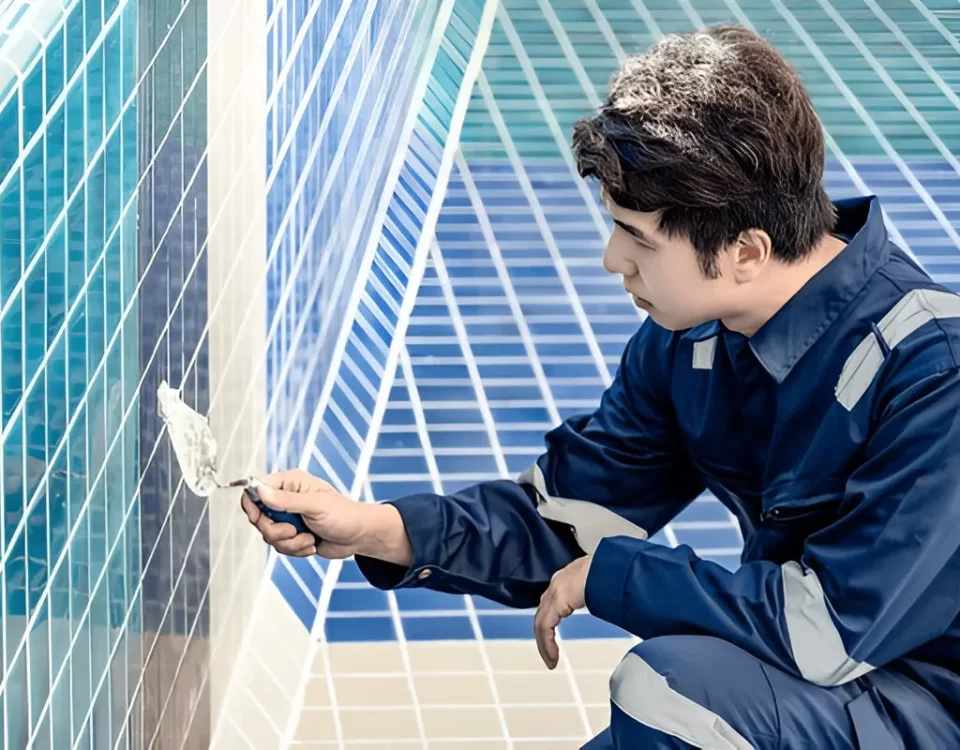Mighty Steel: Unveiling the Secrets of Reinforcement Bars

Revolutionize Your Projects: Master Concrete Mixing Techniques Now!
May 29, 2025
Aquaguard: Your Ultimate Foundation Waterproofing Solution
May 29, 2025Understanding the Importance of Steel Reinforcement Bars in Swimming Pool Construction
In the world of swimming pool construction, steel reinforcement bars, commonly referred to as rebar, play an indispensable role in ensuring the longevity and stability of the structure. Concrete, despite being a formidable building material, is inherently weak in tension. Thus, the incorporation of rebar compensates for concrete’s tensile weaknesses, providing a robust framework that supports the entire aquatic installation.
The Role of Steel Reinforcement Bars
Essentially, steel reinforcement bars serve as the backbone of the pool’s structure. When placed strategically within the concrete, these bars distribute loads and resist various stresses that the structure may encounter over time. This not only includes the weight of the water but also external forces such as ground movement and thermal expansion. Without adequate reinforcement, the risk of cracks and structural failure significantly increases, leading to costly repairs and potential safety hazards.
Enhancing Strength and Durability
One of the key benefits of using steel reinforcement bars lies in their ability to enhance the strength and durability of concrete structures. When concrete is poured around the rebar, the bond created between the two materials increases the overall toughness of the pool. According to data from the American Concrete Institute, properly reinforced concrete can withstand higher loads and resist cracking under environmental stressors, which is paramount for underwater structures like pools that are constantly exposed to moisture and temperature fluctuations.
| Reinforcement Bar Diameter (mm) | Tensile Strength (MPa) | Typical Applications |
|---|---|---|
| 10 | 400 | Residential swimming pools |
| 12 | 460 | Commercial swimming pools |
| 16 | 500 | Olympic-size swimming pools |
Impact of Steel Reinforcement on Aquatic Structures
Furthermore, the significance of rebar is amplified in environments that are susceptible to erosion and corrosion. For swimming pools, where water chemistry can be challenging, concrete alone may not offer sufficient protection against deterioration. The presence of steel bars mitigates these risks, especially when they are coated or treated with protective materials to prevent rust, further extending the lifespan of the entire structure.
Cost-Effectiveness and Longevity
Investing in steel reinforcement bars is not merely a matter of enhancing structural strength; it is, in fact, a cost-effective decision in the long run. The initial investment in quality rebar may seem substantial, yet the benefits accrued from reduced maintenance needs and extended pool lifespan far outweigh these costs. Owners can enjoy their pools with peace of mind, knowing that they have a secure, durable investment that will serve them for many years to come.
Conclusion on Structural Integrity
Ultimately, the crucial role that steel reinforcement bars play in swimming pool construction cannot be overstated. They are essential for achieving the desired stability and safety in aquatic environments, allowing families and individuals to enjoy these recreational spaces worry-free. As pool technologies evolve, the integration of high-quality rebar remains a fundamental aspect of building pools that are not only aesthetically pleasing but also resilient against time and nature.
Different Types of Steel Reinforcement Bars for Swimming Pools
When constructing a swimming pool, the choice of steel reinforcement bars (rebar) is paramount to ensuring structural integrity and longevity. Each type of rebar presents unique attributes that cater to various environmental conditions and financial considerations. Understanding the different options available can significantly impact the durability and maintenance of your pool.
Epoxy-Coated Steel Reinforcement Bars
Epoxy-coated steel reinforcement bars are imbued with a protective layer that shields the steel from corrosive elements, particularly against chlorinated pool water. This makes them an excellent choice for areas prone to chemical exposure. The epoxy coating also helps in preventing rust formation, thereby enhancing the lifespan of the pool structure.
These bars are typically red or green, which visually indicates the protective coating. It is crucial to note that while epoxy-coated bars offer significant advantages, any damage to the coating during installation can compromise their protective qualities. Hence, careful handling and appropriate installation techniques are essential for maintaining their integrity.
Galvanized Steel Reinforcement Bars
Galvanized steel reinforcement bars undergo a process where a protective zinc layer is applied to the steel, creating a barrier against rust and other corrosive agents. This type of rebar is particularly suitable for regions with high humidity or where pools are exposed to various environmental stresses.
One of the primary benefits of galvanized rebar is its affordability compared to other types. It not only offers a reasonable balance of cost-effectiveness and durability but is also relatively easy to work with during construction. However, it is essential to ensure the galvanization is performed correctly, as inadequate coverage can lead to premature corrosion.
Stainless Steel Reinforcement Bars
For the utmost in corrosion resistance, stainless steel reinforcement bars stand out as the premier choice. Composed of a unique alloy that resists rust in even the most corrosive conditions, stainless steel rebar is ideal for swimming pools, especially those using saltwater sanitation systems.
Although more expensive than both epoxy-coated and galvanized options, the long-term savings associated with reduced maintenance and replacement costs often justify the investment. Moreover, stainless steel rebar maintains its structural integrity for decades, making it a byword for longevity in pool construction.
Comparison Table
| Type of Rebar | Corrosion Resistance | Cost | Best Use |
|---|---|---|---|
| Epoxy-Coated | High | Moderate | Chlorinated pool environments |
| Galvanized | Moderate | Low | High humidity areas |
| Stainless Steel | Very High | High | Saltwater systems |
Ultimately, the selection among epoxy-coated, galvanized, and stainless steel reinforcement bars depends on several factors, including environmental conditions, budget constraints, and long-term maintenance considerations. By comprehensively understanding the distinctions among these types of rebar, pool builders and homeowners alike can make informed decisions that pave the way for durable and aesthetically pleasing swimming pool structures.
Factors to Consider When Choosing Steel Reinforcement Bars for Your Swimming Pool
Constructing a swimming pool is a significant investment, not only in terms of finance but also in enduring quality and safety. One of the essential components of a robust swimming pool structure is the selection of appropriate steel reinforcement bars (rebar). Understanding the various factors involved in choosing them can greatly impact the longevity and stability of your pool.
Size of Steel Reinforcement Bars
The size of rebar you choose has direct implications for the strength and load-bearing capacity of your pool. Common sizes include #3, #4, and #5 bars, with the numeral indicating the bar’s diameter in eighths of an inch. For pool structures, a larger size may be required to accommodate the weight of the water, soil, and any surface materials. Typically, a minimum of #4 bars is recommended for reinforced structures, ensuring that the pool can withstand hydrostatic pressure and potential ground shifts.
Grade of Steel Reinforcement Bars
The grade of the steel reinforcement bar is another critical element to consider. Rebar is categorized by yield strength, with common grades being 40, 60, and 75. Higher-grade bars are stronger and can handle more stress, which is essential for pools located in regions prone to seismic activity or expansive soils. It is advisable to assess local building codes and consult with a structural engineer to determine the most suitable grade for your specific location and pool design.
Corrosion Resistance
Swimming pools are often exposed to moisture and chemicals, necessitating robust corrosion resistance. Standard carbon steel rebar can corrode over time, especially when in contact with chlorinated water. It is highly beneficial to consider epoxy-coated or galvanized rebar options, which provide added protection against rust and degradation. Investing in corrosion-resistant bars can significantly prolong the life of your pool and reduce maintenance costs in the long run.
Type of Pool Structure
The type of pool you are constructing—whether it’s a concrete, fiberglass, or vinyl liner pool—can influence your choice of rebar as well. Concrete pools, for instance, require a comprehensive reinforcement plan; hence, the layout pattern and spacing of the rebar bars must be meticulously calculated. In this context, consulting with professionals can ensure that you select the right type of rebar to enhance the structural integrity of your pool.
Local Building Codes and Regulations
Adhering to local building codes is paramount when designing your pool. Each region has specific regulations pertaining to steel reinforcement bars used in construction. These codes will guide the minimum requirements for size, spacing, and corrosion protection, among other factors. Familiarizing yourself with these regulations not only ensures compliance but also helps safeguard your investment by following best practices established by local authorities.
| Rebar Size | Diameter (inches) | Typical Use for Pools |
|---|---|---|
| #3 | 0.375 | Smaller installations or lightweight structures |
| #4 | 0.500 | Standard pools requiring medium reinforcement |
| #5 | 0.625 | Heavy-duty pools needing maximum support |
Ultimately, selecting the right steel reinforcement bars involves careful consideration of various factors that can impact both the construction process and long-term durability of your swimming pool. By assessing size, grade, corrosion resistance, and local regulations, you can make a well-rounded decision that leads to a stable and enjoyable swimming environment.
The Installation Process of Steel Reinforcement Bars in Swimming Pools
The installation of steel reinforcement bars, commonly referred to as rebar, is a fundamental aspect of constructing a durable swimming pool. This process ensures that the pool structure can withstand the immense pressure exerted by water and soil, effectively preventing cracks and structural failure over time. Below is a detailed, step-by-step guide that outlines the proper installation procedures for steel reinforcement bars in swimming pools.
Step 1: Prepare the Pool Dig
The installation of rebar begins with the excavation of the pool area. Ensure that the digging is done with precision, adhering to the pool plans specified for depth and dimensions. Once the area is cleared, a base layer of gravel may be laid to promote drainage and stability. The objective is to create a strong foundation that will support the rebar and the pool shell.
Step 2: Cut and Shape the Rebar
After preparing the site, the next step involves cutting and shaping the steel reinforcement bars. Using the necessary tools, such as rebar cutters and benders, cut the bars according to the measurements provided in engineering specifications. The standard diameter of rebar generally varies from #3 (3/8 inch) to #5 (5/8 inch), depending on the project requirements. Shape the rebar to fit the contours and corners of the pool, ensuring comprehensive coverage in all critical structural areas.
Step 3: Lay Out the Rebar
With the rebar prepared, it’s time to lay it out within the pool cavity. Align the bars carefully, ensuring that they are evenly spaced to provide maximum tensile strength. A common configuration is to place horizontal and vertical bars in a grid-like pattern. It’s vital that the spacing between the bars complies with local building codes, typically ranging from 12 inches to 18 inches apart. For further structural integrity, incorporate additional bars at corners and edges where stress concentrations may occur.
Step 4: Secure the Rebar
Once positioned, securing the steel rebar is crucial to maintain alignment and ensure it remains in place during the concrete pouring process. Utilize rebar ties or wire to bind the bars together, creating a stable framework. Make sure to use stainless steel or epoxy-coated ties to prevent corrosion, which can compromise the integrity of the steel over time. Double-check the alignment of each bar to prevent any misplacement that could lead to structural weaknesses.
Step 5: Covering the Rebar
Prior to pouring the concrete, one of the most critical aspects is to ensure that the rebar is adequately covered. Following the recommendations of structural engineers, maintain a minimum concrete cover of at least 2 inches to protect the steel from exposure. Placing plastic spacers can assist in achieving proper coverage and facilitate uniformity throughout the structure.
Step 6: Pour the Concrete
Finally, pour the concrete to encapsulate the rebar, forming the backbone of the swimming pool structure. As the concrete pours, utilize a vibrator to eliminate any air pockets and ensure a dense, solid mix. Monitoring the curing process is essential—allow the concrete to set properly before any further construction occurs. Pay close attention to the weather conditions during the curing phase, as temperature fluctuations can affect the integrity of the set.
| Rebar Diameter | Typical Uses |
|---|---|
| #3 (3/8 inch) | Lightweight structures, thin slabs |
| #4 (1/2 inch) | Medium pools and slabs |
| #5 (5/8 inch) | Heavy-duty swimming pools, large structural applications |
Common Issues and Challenges with Steel Reinforcement Bars in Swimming Pools
Steel reinforcement bars (commonly known as rebar) play an integral role in the structural integrity of swimming pools. However, several challenges can arise during installation and over the lifespan of the pool. With proper understanding and foresight, these issues can be mitigated, ensuring both longevity and stability for this essential aquatic feature.
Corrosion: The Silent Invader
One of the most pressing concerns related to steel reinforcement bars in swimming pools is corrosion. The presence of chlorinated water can lead to the deterioration of rebar over time. When corrosion occurs, it compromises the strength of the bars, potentially leading to structural failure. The chlorides present in pool water accelerate this process, making it vital to take precautionary measures.
To combat corrosion, the use of epoxy-coated rebar is recommended. This specialty coating provides an additional barrier against chlorides. Additionally, maintaining proper water chemistry, such as balanced pH levels and appropriate chlorine concentrations, can significantly reduce the risk of corrosion.
Incorrect Placement: A Recipe for Disaster
Improper placement of steel reinforcement bars can lead to severe structural deficiencies. If bars are installed too close to the surface, they are at heightened risk of corrosion. Conversely, if placed too far from surfaces, they may not effectively support the surrounding concrete during stress or tension.
To mitigate this risk, adhering strictly to industry standards and guidelines during installation is crucial. Employing a knowledgeable contractor experienced in pool construction can ensure that rebars are correctly positioned. Verification of rebar placement and spacing, preferably through the use of templates, can further prevent mishaps.
Inadequate Support: A Structural Threat
In some cases, insufficient support for the reinforcement bars during concrete pouring can lead to displacement and weakening of the structure. This can occur if the formwork is not adequately designed to support the weight of wet concrete, leading to displacement of the rebar before it is encased.
To address this issue, it is essential to use robust and accurate formwork that can withstand the pressure of the concrete. Moreover, ensuring that rebar supports, such as rebar chairs and spacers, are used can prevent displacement and maintain the correct positioning throughout the pouring process.
Table: Common Issues and Preventive Solutions
| Issue | Potential Solutions |
|---|---|
| Corrosion | Use epoxy-coated rebar; maintain balanced pool chemistry. |
| Incorrect Placement | Follow industry best practices; hire experienced contractors. |
| Inadequate Support | Utilize robust formwork and support materials. |
By understanding these challenges and implementing effective solutions, pool builders and owners can significantly enhance the durability and longevity of steel reinforcement bars within swimming pool constructions. Whether considering installation or maintenance, proactive measures are pivotal to safeguard against the pitfalls associated with rebar.
Maintenance and Care Tips for Steel Reinforcement Bars in Swimming Pools
Steel reinforcement bars, commonly known as rebar, play a crucial role in enhancing the structural integrity of swimming pools. However, to ensure their longevity and optimal performance, proper maintenance and care are paramount. The following guidelines will help you keep your steel reinforcement bars in excellent condition, contributing to a durable and safe pool environment.
Regular Inspections
Conducting regular inspections is essential for early detection of potential issues with steel reinforcement bars. Inspect the bar placements at least twice a year, looking for any signs of corrosion, misalignment, or exposure. Pay particular attention to the areas where bars are embedded in concrete, as these spots are prone to moisture accumulation, which can facilitate rust formation. Utilize a wire brush to clear away any debris or loose concrete, allowing for a clearer assessment of the bar’s condition.
Cleaning Techniques
Cleaning steel reinforcement bars is pivotal in preventing the build-up of materials that may cause deterioration. Use a non-abrasive cleaner and a stiff brush to remove dirt, algae, and oils that may have collected over time. Avoid harsh chemicals, as these can enhance corrosion rather than alleviate it. After cleaning, rinse the bars thoroughly with clean water to eliminate any residues that could compromise their integrity.
Corrosion Prevention Methods
To safeguard steel reinforcement bars from corrosion, consider implementing various protective measures. The application of anti-corrosive coatings is highly effective; these coatings create a protective barrier against moisture and chemical exposure. Additionally, maintaining proper water chemistry in your pool is vital. Ensure that pH levels remain between 7.2 and 7.6, and monitor the chlorine levels regularly, as imbalanced chemicals can lead to accelerated corrosion of the rebar.
Environmental Considerations
Environmental factors such as humidity and exposure to harsh weather conditions can significantly impact the durability of reinforcement bars. It is advisable to invest in covers or protective enclosures that shield your pool from excessive rainfall or snow accumulation. Additionally, ensure that drainage systems around the pool are efficient, preventing stagnant water that can promote rust in the bars.
Professional Assessments
While DIY inspections and maintenance are invaluable, enlisting the expertise of a professional should not be overlooked. Schedule professional assessments annually to evaluate the condition of your steel reinforcement bars thoroughly. Certified inspectors can identify hidden issues that may go unnoticed during regular checks and suggest appropriate remediation strategies.
Table: Recommended Maintenance Schedule for Steel Reinforcement Bars
| Action | Frequency |
|---|---|
| Visual Inspection | Every 6 months |
| Deep Cleaning | Annually |
| Corrosion Protection Application | As needed |
| Professional Assessment | Annually |
Future Trends and Innovations in Steel Reinforcement Bars for Swimming Pools
The construction industry is undergoing a seismic shift as emerging technologies and innovative materials pave the way for enhanced structural integrity and longevity of swimming pools. Among these developments, steel reinforcement bars (rebar) are at the forefront, ensuring that swimming pools not only exhibit aesthetic appeal but also withstand the test of time. Innovative advancements in rebar technology promise to revolutionize swimming pool construction, offering a harmonious blend of strength, sustainability, and versatility.
Advancements in Material Science
Recent innovations in material science have given rise to high-strength, lightweight steel reinforcement bars designed specifically for swimming pool applications. One notable advancement is the development of corrosion-resistant steel, which includes special coatings that protect the rebar from persistent moisture and chemical exposure prevalent in pool environments. The use of epoxy-coated rebar enhances resistance to chlorides and other corrosive elements, thereby extending the lifespan of swimming pools and reducing maintenance costs.
Smart Reinforcement Technologies
Emerging technologies are transforming steel reinforcement bars into intelligent materials. Smart rebar equipped with sensors capable of monitoring structural integrity in real-time is gaining traction in the construction of swimming pools. These sensors can detect stress, temperature fluctuations, and corrosion levels, allowing for proactive maintenance and early detection of potential issues before they escalate into costly repairs. This innovative approach not only enhances the durability of swimming pools but also optimizes long-term resource allocation.
Design Flexibility through 3D Printing
The advent of 3D printing technology is setting the stage for new possibilities in pool construction. By allowing for the creation of customized reinforcement structures, 3D-printed reinforcements can enhance design flexibility while reducing waste. This innovation in design methodology enables architects and engineers to tailor rebar configurations that suit unique architectural forms, resulting in visually striking and structurally sound swimming pools. Such personalized approaches can also address specific environmental conditions, making pools safer and more efficient.
Green Construction Practices
As sustainability becomes a focal point in modern construction, the steel reinforcement industry is adapting with eco-conscious practices. Recycled steel is increasingly being utilized in the production of reinforcement bars, decreasing the carbon footprint associated with new steel production. Furthermore, innovations in rebar manufacturing aim to minimize waste through streamlined processes and energy-efficient methods. Emphasizing green construction practices will not only appeal to environmentally aware consumers but also contribute to a more sustainable future for the swimming pool industry.
Implementing Modular Construction Techniques
Modular construction techniques are gaining momentum, allowing for the prefabrication of essential pool elements, including steel reinforcement systems. This method reduces construction time, labor costs, and the potential for on-site errors. By using pre-manufactured rebar assemblies, contractors can ensure a higher level of quality control and streamline installation processes. Embracing modular construction will enhance project efficiency and facilitate the rapid delivery of swimming pool projects while maintaining structural robustness.
Table: Key Innovations in Steel Reinforcement Bars for Swimming Pools
| Innovation | Description | Benefits |
|---|---|---|
| Corrosion-Resistant Coatings | Protective layers applied to rebar. | Extends lifespan, reduces maintenance. |
| Smart Rebar | Reinforcement bars with integrated sensors. | Real-time monitoring, proactive maintenance. |
| 3D Printing | Custom reinforcement structures. | Design flexibility, minimal waste. |
| Recycled Steel | Use of repurposed materials. | Lower carbon footprint, eco-friendly. |
| Modular Construction | Prefabricated rebar assemblies. | Increased efficiency, quality control. |
The convergence of these trends indicates a promising trajectory for the future of steel reinforcement bars in the swimming pool sector. By embracing innovative approaches, industry stakeholders can enhance the effectiveness of swimming pool construction while satisfying the increasing demand for sustainability and durability. As technology continues to evolve, it is evident that the next generation of steel reinforcement bars will be integral to shaping the swimming pools of tomorrow.
Stay Updated: Discover more about Construction & Materials swimming pool on Google News

Javier Morales is passionate about pool design, maintenance, and outdoor living. With years of hands-on experience, he offers practical tips, creative ideas, and expert insights to help readers make the most of their pool spaces. At Piscina Planet, Javier shares everything from seasonal care guides to the latest trends in pool innovation.




